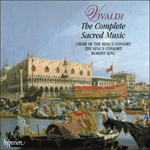
Welcome to Hyperion Records, an independent British classical label devoted to presenting high-quality recordings of music of all styles and from all periods from the twelfth century to the twenty-first.
Hyperion offers both CDs, and downloads in a number of formats. The site is also available in several languages.
Please use the dropdown buttons to set your preferred options, or use the checkbox to accept the defaults.

The final movement, ‘Et in saecula saeculorum’, is a transposed version of the outer (‘A’) section of a terzet in da capo form from Vivaldi’s opera La fida ninfa (Verona, 1732). The text of the operatic terzet expresses the gyrations of the wheel of fortune, whereas the second part of the Doxology expresses the immutability of eternity. By using musical motifs that can be held to represent both circular motion (the opening of the tenor line) and the constancy of the ages (its continuation as a counter-subject in long notes), Vivaldi manages to have things both ways. This borrowing has an appositeness worthy of Handel’s best efforts in the same direction.
from notes by Michael Talbot © 1999
Le mouvement final, «Et in saecula saeculorum», est une version transposée de la section extrême («A») d’un tercet, de forme da capo, extrait de l’opéra vivaldien La fida ninfa (Vérone, 1732). Le texte de ce tercet exprime les girations de la roue de la fortune, tandis que la seconde partie de la doxologie traduit l’immuabilité de l’éternité. En recourant à des motifs musicaux pouvant être tenus pour des symboles du mouvement circulaire (l’ouverture de la ligne de ténor) et de la constance des siècles (sa continuation comme contre-sujet en longues), Vivaldi parvient à couvrir les deux notions. Cet emprunt est d’une pertinence digne des meilleurs efforts de Haendel dans le même sens.
extrait des notes rédigées par Michael Talbot © 1999
Français: Hyperion Records Ltd
Der letzte Satz „Et in saecula saeculorum“ ist eine transponierte Version des Kopfabschnitts eines Terzetts im Dakapoformat aus Vivaldis Oper La fida ninfa (Verona, 1732). Der Text des Opernterzetts setzt die Drehungen eines Glücksrads um, während der zweite Teil der Doxologie das Unabänderliche der Ewigkeit darstellt. Indem er musikalische Motive benutzt, die sowohl eine Kreisbewegung (so zu Beginn der Tenorpartie) als auch die Beständigkeit der Zeitläufte andeuten können (in deren weiterem Verlauf als Kontrasubjekt mit langen Notenwerten), gelingt es Vivaldi, beidem zu genügen. Die Entlehnung ist so gelungen, daß sie sich mit Händels erfolgreichsten Bemühungen auf diesem Gebiet messen kann.
aus dem Begleittext von Michael Talbot © 1999
Deutsch: Anne Steeb/Bernd Müller
 Vivaldi: The Complete Sacred Music Vivaldi: The Complete Sacred Music‘For King's sterling service to the Vivaldian cause, one of his most important recording and satisfying projects to date, I am thankful’ (Gramophone) ‘If you're waiting for the perfect collection of Vivaldi's sacred music, this is it. It was a happy day when this beautiful boxed set arrived in my m ...» More |

